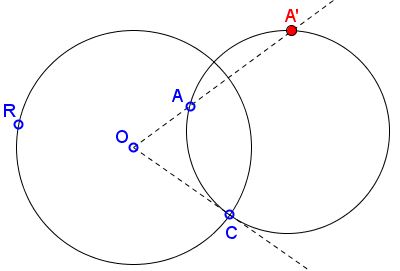Inversion: Reflection in a Circle: What is it?
A Mathematical Droodle
|Activities| |Contact| |Front page| |Contents| |Geometry|
Copyright © 1996-2018 Alexander BogomolnyInversion: Reflection in a Circle
Let there be a circle t with center O and radius R. (In the applet, R also denotes a draggable point on the circle, such that OR is the radius of the circle.) And let there be a point A that could be located anywhere in the plane, except the center O. There is a whole bunch of circles that pass through A and that a perpendicular to t. C is one of the points -- the one that could be dragged -- where the given circle and that through A intersect. The applet suggests the following statement:
All circles through point A and perpendicular to t also pass through another point A'.

The situation is quite reminescent of reflection in a line. Two points A and A' symmetric in a straight line lie at equal distances to the line on a perpendicular to that line. Therefore, any circle with center on the line that passes through one of the points passes necessarily through the other. These are the circles perpendicular to the line. Our statement is obtained if the word "line" is replaced with the word "circle".
The prove of the statement is simple. Let g be a circle that passes through A and is perpendicular to t. Let A' be a second point of intersection of OA with g. Then OC is tangent to g. Therefore
(1)
OA·OA' = OC2 = R2.
The latter implies that the location of point A' does not depend on circle g. Indeed, A' lies on the line OA at distance equal to R2/OA. The point A' is known as the inverse (or inversion, or reflection) of A in t. From (1) it is obvious that if A' is the inverse of A, then A is the inverse of A', so that the points are said to be symmetric in the circle, or to be reflections of each other. A' is said to be the inverse image of A with respect to, or in, the given circle. Obviously, if A' is the inverse image of A, then A is the inverse image of A'.
Except of the center of t, which is known as the center of inversion, all points A in the plane have inverse images A'. The term inversion also applies to thus defined transformation of the plane. The transformation maps the points inside t to the points in its exterior, and vice versa. The points on t are fixed under that transformation, as are the circles perpendicular to it. The latter, of course, are not fixed pointwise. Lines through the center of inversion (with the exception of the center itself) also have that property. The curves that coincide with their own inverse are called anallagmatic.
The center of inversion is often [Coxeter] left over as a point with no inverse image, but sometimes [Courant] is said to be mapped to the point at infinity. Caution must be exercised as this is not the same point at infinity where, for example, all parallel lines meet.
(1) leads to an alternative, more algebraic, definition of inversion. R is known as the radius of inversion, R2 as the power of inversion.
Inversion was invented by J. Steiner sometime around 1830.
(A simple tool is available for experimentation with the inversion.)
References
- R. Courant and H. Robbins, What is Mathematics?, Oxford University Press, 1996
- H. S. M. Coxeter, Introduction to Geometry, John Wiley & Sons, 1961
- H.S.M. Coxeter, S.L. Greitzer, Geometry Revisited, MAA, 1967
- Liang-shin Hahn, Complex Numbers & Geometry, MAA, 1994
- D. Hilbert and S. Cohn-Vossen, Geometry and Imagination, Chelsea Publishing Co, NY 1990.
- H.Rademacher and O.Toeplitz, The Enjoyment of Mathematics, Dover Publications, 1990.
Inversion - Introduction
- Angle Preservation Property
- Apollonian Circles Theorem
- Archimedes' Twin Circles and a Brother
- Bisectal Circle
- Chain of Inscribed Circles
- Circle Inscribed in a Circular Segment
- Inversion: Reflection in a Circle
- Circle Inversion Tool
- Feuerbach's Theorem: a Proof
- Four Touching Circles
- Hart's Inversor
- Inversion in the Incircle
- Inversion with a Negative Power
- Miquel's Theorem for Circles
- Peaucellier Linkage
- Polar Circle
- Poles and Polars
- Ptolemy by Inversion
- Radical Axis of Circles Inscribed in a Circular Segment
- Steiner's porism
- Stereographic Projection and Inversion
- Tangent Circles and an Isosceles Triangle
- Tangent Circles and an Isosceles Triangle II
- Three Tangents, Three Secants
- Viviani by Inversion
- Simultaneous Diameters in Concurrent Circles
- An Euclidean Construction with Inversion
- Construction and Properties of Mixtilinear Incircles
- Two Quadruplets of Concyclic Points
- Seven and the Eighth Circle Theorem
- Invert Two Circles Into Equal Ones
|Activities| |Contact| |Front page| |Contents| |Geometry|
Copyright © 1996-2018 Alexander Bogomolny73561726
